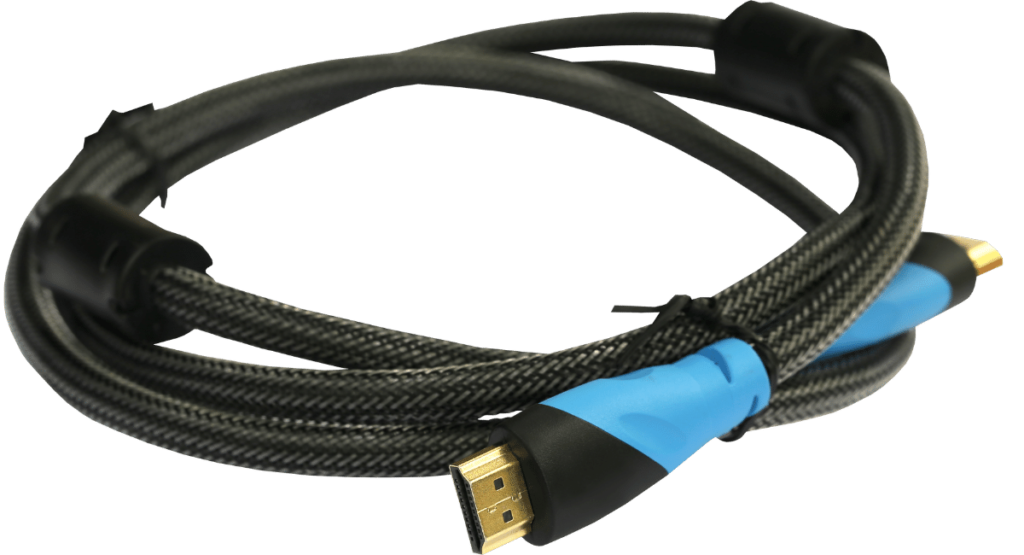What Is HDMI Cable? – [In Brief]
HDMI stands for (High-Definition Multimedia Interface). It is a standard digital interface for transmitting uncompressed video and audio data between devices.
HDMI cables are used to connect a wide variety of devices, including TVs, Blu-ray players, game consoles, and computers.
HDMI cables are available in a variety of lengths, so you can choose the right length for your needs. They are also available in different resolutions, so you can choose the right resolution for your devices.
It’s important to note that HDMI cables come in various versions (e.g., HDMI 1.4, HDMI 2.0, HDMI 2.1), each supporting different features and data transfer capabilities.
Lately, the Fiber Optic HDMI Cable is invented.

When purchasing an HDMI cable, it’s essential to choose one that meets the requirements of your devices and the specific features you need (e.g., 4K support, Ethernet support).
For most standard audiovisual setups, a standard HDMI cable should suffice.
How To Use HDMI Cable?
HDMI cables are very easy to use. Simply connect one end of the cable to the HDMI port on your source device and the other end to the HDMI port on your display device. Once the cable is connected, you should be able to see the video and audio from your source device on your display device.
HDMI cables have standardized connectors on each end, allowing them to be easily plugged into HDMI-compatible devices. These connectors typically have 19 pins (for standard HDMI) or 29 pins (for HDMI with Ethernet), which facilitate the transfer of data between devices.
Here are some of the benefits of using HDMI cables:
- High-Definition Video: HDMI cables support high-definition video resolutions, such as 720p, 1080p, 4K, and even 8K, delivering sharp and detailed images on compatible displays like HDTVs, computer monitors, and projectors.
- Audio Support: HDMI cables can transmit high-quality digital audio along with video signals. They support various audio formats, including stereo, surround sound, and advanced audio codecs like Dolby TrueHD and DTS-HD Master Audio.
- Consumer Electronics Connectivity: HDMI is commonly used to connect various consumer electronics devices, such as TVs, Blu-ray players, gaming consoles, home theater systems, laptops, digital cameras, and more.
- Plug and Play: HDMI connections are easy to set up and use. When you connect two HDMI-compatible devices using an HDMI cable, they typically recognize each other automatically, and the audio and video signals are transmitted seamlessly.
- CEC (Consumer Electronics Control): HDMI cables with CEC capabilities allow compatible devices to communicate with each other, enabling functionalities like turning on/off multiple devices with a single remote and controlling volume and playback.
- Ethernet Channel (optional): Some HDMI cables also feature an Ethernet channel, allowing for an internet connection to be transmitted through the HDMI cable, typically useful for internet-enabled devices.
If you are looking for a high-quality digital interface for connecting your devices, then an HDMI cable is a great option. They are easy to use, support multiple formats, and are very durable.
Here are some of the most common types of HDMI cables:
- Standard HDMI cable: This is the most common type of HDMI cable. It supports resolutions up to 1080p.
- High-Speed HDMI cable: This type of cable supports resolutions up to 4K Ultra HD.
- Premium High-Speed HDMI cable: This type of cable supports resolutions up to 8K Ultra HD.
- eARC HDMI cable: This type of cable supports an enhanced audio return channel (eARC), which allows you to send high-quality audio from your TV to your soundbar or AV receiver.
When choosing an HDMI cable, it is important to consider the resolution of your devices and the type of content you will be watching. If you are watching 4K Ultra HD content, then you will need a High-Speed HDMI cable or a Premium High-Speed HDMI cable. If you are watching 8K Ultra HD content, then you will need a Premium High-Speed HDMI cable or an eARC HDMI cable.
Why HDMI Cable And Not VGA?
HDMI and VGA are two of the most common video connection standards. They are both used to connect devices such as TVs, monitors, and projectors. However, there are some key differences between the two standards.
HDMI stands for High-Definition Multimedia Interface. It is a digital standard that can transmit uncompressed video and audio data. VGA stands for Video Graphics Array. It is an analog standard that can transmit only video data.
Here is a table summarizing the key differences between HDMI and VGA:
| Feature | HDMI | VGA |
|---|---|---|
| Type | Digital | Analog |
| Supported resolutions | Up to 8K Ultra HD | Up to 1080p |
| Supported audio formats | Multiple | Stereo only |
| Supported features | HDCP, ARC, eARC | None |
| Durability | More durable | Less durable |
| Price | More expensive | Less expensive |
As you can see, HDMI is the more advanced standard. It supports higher resolutions, more audio formats, and more features. However, it is also more expensive and less durable than VGA.
If you are looking for the best possible picture and sound quality, then HDMI is the way to go. However, if you are on a budget or if you are connecting older devices, then VGA may be a better option.
Here are some additional considerations when choosing between HDMI and VGA:
- Compatibility: HDMI is the more widely supported standard. Most newer devices will have HDMI ports, while older devices may only have VGA ports.
- Length: HDMI cables are available in longer lengths than VGA cables. This is because HDMI uses a digital signal, which is less susceptible to interference than an analog signal.
- Security: HDMI supports HDCP, which is a security feature that prevents unauthorized copying of digital content. VGA does not support HDCP.
Ultimately, the best choice for you will depend on your specific needs and requirements. If you are not sure which standard is right for you, then it is best to consult with a professional.
HDMI Cables Types
HDMI cables come in different types and versions, each designed for specific purposes or capabilities.
Here are some common types of HDMI cables:
- Standard HDMI Cable: This is the most basic type of HDMI cable and supports resolutions up to 1080i (interlaced) or 720p (progressive scan). It is suitable for connecting HD devices like DVD players, gaming consoles, and some older TVs.
- High-Speed HDMI Cable: This type of cable supports higher resolutions and refresh rates, including 1080p, 4K, and even 8K. It is capable of handling more bandwidth and is suitable for modern HDTVs, 4K Blu-ray players, gaming consoles, and other high-resolution devices.
- Premium High-Speed HDMI Cable: These cables are certified to meet certain performance standards and are ideal for 4K HDR (High Dynamic Range) content and high refresh rates. They offer better shielding and enhanced signal integrity.
- Ultra High-Speed HDMI Cable: This type of cable is designed for the most demanding applications, such as 8K resolution video at high refresh rates (60Hz) and 4K at 120Hz. It also supports additional features like Variable Refresh Rate (VRR) and Quick Frame Transport (QFT) for smoother gaming experiences.
- HDMI with Ethernet: This type of cable includes an additional Ethernet channel within the cable, allowing devices to share an internet connection without the need for a separate Ethernet cable.
- Mini HDMI and Micro HDMI: These are smaller HDMI connectors designed for use with smaller devices like certain cameras, camcorders, and tablets. Mini HDMI has a smaller connector than standard HDMI, while Micro HDMI is even smaller than Mini HDMI.
- HDMI to DVI Cable: While not a different type of HDMI cable, this cable allows you to connect devices with an HDMI output to devices with a DVI input (usually found on older monitors and some computers).
When choosing an HDMI cable, it’s important to consider the resolution and refresh rate requirements of your devices and the specific features you need.
In most cases, a High-Speed HDMI cable should be sufficient for typical home entertainment setups. However, for advanced gaming, 4K/8K HDR content, or specialized applications, you might need an Ultra High-Speed HDMI cable.
Always check the specifications of your devices and the HDMI cable to ensure compatibility.
HDMI Cables Versions
There are currently 7 versions of HDMI cables:
- HDMI 1.0 (2002): This was the first version of HDMI and it supports resolutions up to 1080p at 60Hz.
- HDMI 1.1 (2004): This version added support for Deep Color and xvYCC.
- HDMI 1.2 (2005): This version added support for Ethernet and 3D.
- HDMI 1.3 (2006): This version doubled the bandwidth of HDMI, allowing for resolutions up to 1080p at 120Hz and 4K at 24Hz.
- HDMI 1.4 (2009): This version added support for 4K at 30Hz, 3D at 60Hz, and Audio Return Channel (ARC).
- HDMI 2.0 (2013): This version doubled the bandwidth of HDMI 1.4, allowing for resolutions up to 4K at 60Hz and 8K at 30Hz.
- HDMI 2.1 (2017): This is the latest version of HDMI and it supports resolutions up to 8K at 60Hz, 4K at 120Hz, and dynamic HDR.
It is important to note that not all HDMI cables are created equal. Some cables are only capable of supporting certain resolutions and refresh rates. Therefore, it is important to check the specifications of your devices and cables to ensure that they are compatible.
HDMI 2.1 Vs. older versions
Here is a table summarizing the key features of each HDMI version:
| HDMI Version | Bandwidth | Resolution | |
|---|---|---|---|
| HDMI 1.0 | 4.95 Gbps | 1080p @ 60Hz | |
| HDMI 1.1 | 4.95 Gbps | 1080p @ 60Hz | |
| HDMI 1.2 | 4.95 Gbps | 1080p @ 60Hz, 3D @ 24Hz | |
| HDMI 1.3 | 10.2 Gbps | 1080p @ 120Hz, 4K @ 24Hz | |
| HDMI 1.4 | 10.2 Gbps | 4K @ 30Hz, 3D @ 60Hz, ARC | |
| HDMI 2.0 | 18.0 Gbps | 1080p @ 240Hz, 4K @ 60Hz, HDR | |
| HDMI 2.1 | 48 Gbps | 8K @ 60Hz, 4K @ 120Hz, dynamic HDR |
If you have a 4K TV, gaming console, or other devices that support higher resolutions and refresh rates, using an HDMI 2.0 cable can ensure that you get the best performance and compatibility.
![What Is Fiber Optic HDMI Cable? – [In Brief]](https://radouane.me/hub/wp-content/uploads/2023/07/Fiber-Optic-HDMI-Cable-768x416.png)

2 Comments